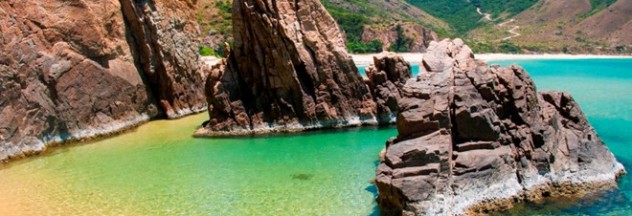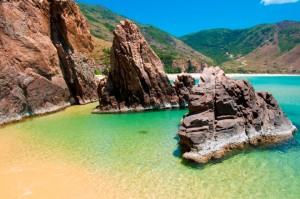Binh Dinh in the Central Province of Quang Trung is blessed with a naturally pristine beauty and rich history. As such, it has become a world-class tourist destination that continues to prosper as time goes by.
Nui Ba (Ba Mountains), also known as Pho Chinh Mountains, is one of the most beautiful in Binh Dinh Province with its green valleys and fresh streams. It has 60 mounts, ideal for eco-tourism and adventure travel. Among the popular tourist spots here are: Hang Rai Mount in the South East; Heo Mount in the North East; and Chuong Mount or Chuong Son Mountain, the highest of the three at 900 metres and said to resemble a giant upside down bell. It was named as such in the first place because Chuong means bell in the Vietnamese language. The Vong Phu Stones is something which visitors shouldn’t miss because of its interesting century-old legend of a young wife and her son who waited for the husband for a very long time that they eventually turned to rocks. Vong Phu means Waiting for Husband. It is a symbol of faithfulness and love for family. Remnants of the Chiem Capital of the Cham Kingdom up to the Tay Son Revolution, the military base of the Vietnam revolutionaries during the fight against the French and American invaders can also be found at Ba Mountains.
Ham Ho is a one-kilometre downstream area of the Kut River in Tay Son which got its fame because the local people could be heard shouting here during the dry season praying for rain. The name literally means “Yelling Cellar” in Vietnamese. All throughout the year though, the place is alive with a dense forest, fresh streams, steep cliffs and unique-shaped marbles. The latter is so one-of-a-kind that they became tourist attractions, even earning names like Chess Stone, Flying Fish and Gates of Life and Death (also known as the Giant’s Feet). In the flood season, Ham Ho is also swarmed with people because of the abundance of flying fish which catches interest for its “rebellious” character of swimming against instead of with the river flow.
Thi Nai Lagoon is the biggest lagoon in Binh Dinh at 10 kilometres long and four kilometres wide and with different kinds of fish. In the middle is a mount which looks like a temple that people built a pagoda on it to worship the god of water. During dusk and dawn, the lagoon looks like a fairy land with mist enveloping the whole place.
If you’re looking for tranquility, Ky Co Island is the place to go. There are no houses on the island save for a few thatched huts of a local company. There are no stores or diners so visitors have to bring their own food which they can buy at Nhon Ly Market, equally famous for its immaculate beaches and overall spectacular view.
Hoang De Citadel was built at the end of the 10th century during the reign of Emperor Yangpuku Vijaaya. It was the last capital of the Champa Kingdom ruled by the Cham Kings between the 11th and 15th centuries. It was occupied by the Nguyen Dynasty in 1799 and renamed it Binh Dinh Citadel. It was destroyed in 1814 by the same dynasty and rebuilt five kilometres South of the orifinal location. It is an important historical structure because it contains relics such as stone walls, moats, granite-tiled roads, square wells, statues (of lions and elephants), (ten) towers and (two) ancient pagodas.
Nhon Ly Dunes are famous sand dunes situated next to a beach (Nhon Ly) and elevated at 100 metres. It is a popular tourist destination because of its breathtaking sight and adventurous activities.
The Clusters of Champ Towers are composed of 13 towers grouped in eight and have a distinct architectural design. The Twin Towers were built in the late 12th century and made up of one small and one big tower. The Banh It tower complex has a unique structure reflective of Cham architecture. Canh Tien Tower has an arch which looks like a sharp spear and simple walls. Long Cham Tower is a complex of three towers. Cham Pa Towers displays remnants of the Cham Pa civilization. Duong Long Towers has three spires and carved brick stones all around designed in elephant, eagle and garuda – distinctive Cham Pa animals. The other towers are: Binh Lam; Thu Thien; Phu Loc; and Cham, with one-of-a-kind ancient design symbolic of Cham.
Swallow Island, or Yen Island or Phuong Mai Island is a popular tourist destination because of a mountain which resembles a dinosaur said to stand guard of the island against strong winds and big waves. But as the name suggests, the island is home to many swallow birds which is also an in-demand delicacy all over the world. There are two main kinds of swallows in the island: Yen Co and Yen Sao. The former is larger than the latter and build their nests on top of the mountains using grass. The latter has a small body and find food by flying or catching it in the sea. They can fly for ten hours straight. Their nest is made of saliva which they pull to make threads and are placed neatly sticking out from caves and cliffs. They use their nests to breed.
Ghenh Rang is naturally blessed with amazing mountains, forests, beaches and islands unlike anywhere else. It has several significant sites in different parts of the island such as the Lion’s Head, Waiting Statue, Lying Elephant, Bear Rocks and Chong Islet on the South. In the North East is the Queen Beach, named as such because of King Bao Dai who in 1927 reserved the entire beach for his wife, Queen Nam Phuong. He even built a villa just for his family to relax. The beach is also known as “Egg Stone” Beach because it is said to resemble a big tortoise filled with jade and granite eggs. Ghenh Rang is also famous for its garden of rock “animals,” strange rock eggs and garden houses built among plants and trees. This is also where the popular poet Han Mac Tu used to live and where his grave can be visited by tourists.
Bau Da Village is home to the popular bau da liquor, a transparent concoction made by hand and made from newly-harvested rice grains and “special” water. It is made by distilling it over a straw and then heating it by husks. It is said to taste better than the world-famous Johnny Walker brandy. It is said to create “sensations of fire and ice,” sending literal chills if you put or get even just a drop of it on your skin.
Cu Lao Xanh or Green Islet is named as such because of its beautiful green water which encompasses 75% of the place. The population is small and scattered, mostly old people and young children. Visitors can experience both serenity and fun with only a few people around and go fishing and barbeque party at the beach. The island is 450 hectares big, 75% of which is composed of forests and mountains. It has great potential for sea economic development and eco-tourism because of its huge water and land resources. There is also a lighthouse on the island built in 1890, one of the biggest in Vietnam, which has also become a tourist attraction.
With such features, who wouldn’t want to visit Binh Dinh?

